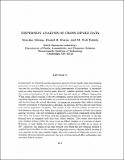Dispersion Analysis Of Cross-Dipole Data
Author(s)
Huang, Xiaojun; Burns, Daniel R.; Toksoz, M. Nafi
Download1998.14 Huang et al.pdf (9.562Mb)
Other Contributors
Massachusetts Institute of Technology. Earth Resources Laboratory
Metadata
Show full item recordAbstract
In this paper, we demonstrate that dispersion analysis of cross-dipole data has promising
potential not only for differentiating stress-induced anisotropy from intrinsic anisotropy, but also for providing information on radial heterogeneity of formations. A dispersion analysis using improperly rotated data, however, exhibits spurious results because of the cross-contamination of the fast and slow flexural waves at different frequencies. When using Alford rotation, if the two orthogonal sources and/or receivers do not have matching signatures, the estimation of polarization directions of the split flexural waves will deviate from the actual directions, an important parameter that reflects vertical fracture orientation or regional stress direction. In addition, the two split flexural waves may not be separated completely. We present a new rotation scheme carried out in the frequency domain that takes into account signature mismatch of both the sources and the receivers. The new technique is applied to a set of four-component cross-dipole data from the Cymric Oil Field, and the estimated polarization direction of the fast flexural wave is compared with that from Alford rotation. The results show that the new rotation scheme yields the same trend as Alford rotation as a function of depth. However, at each depth, the results of these two methods can differ by as many as 50°. Moreover, the length of the time window over which the new rotation method is applied has little effect on the crossover of dispersion curves, whereas Alford rotation is very sensitive to the time window length. Since the crossover of dispersion curves is an indicator of stress-induced anisotropy, the new rotation method offers advantages over standard Alford rotation.
Date issued
1998Publisher
Massachusetts Institute of Technology. Earth Resources Laboratory
Series/Report no.
Earth Resources Laboratory Industry Consortia Annual Report;1998-14